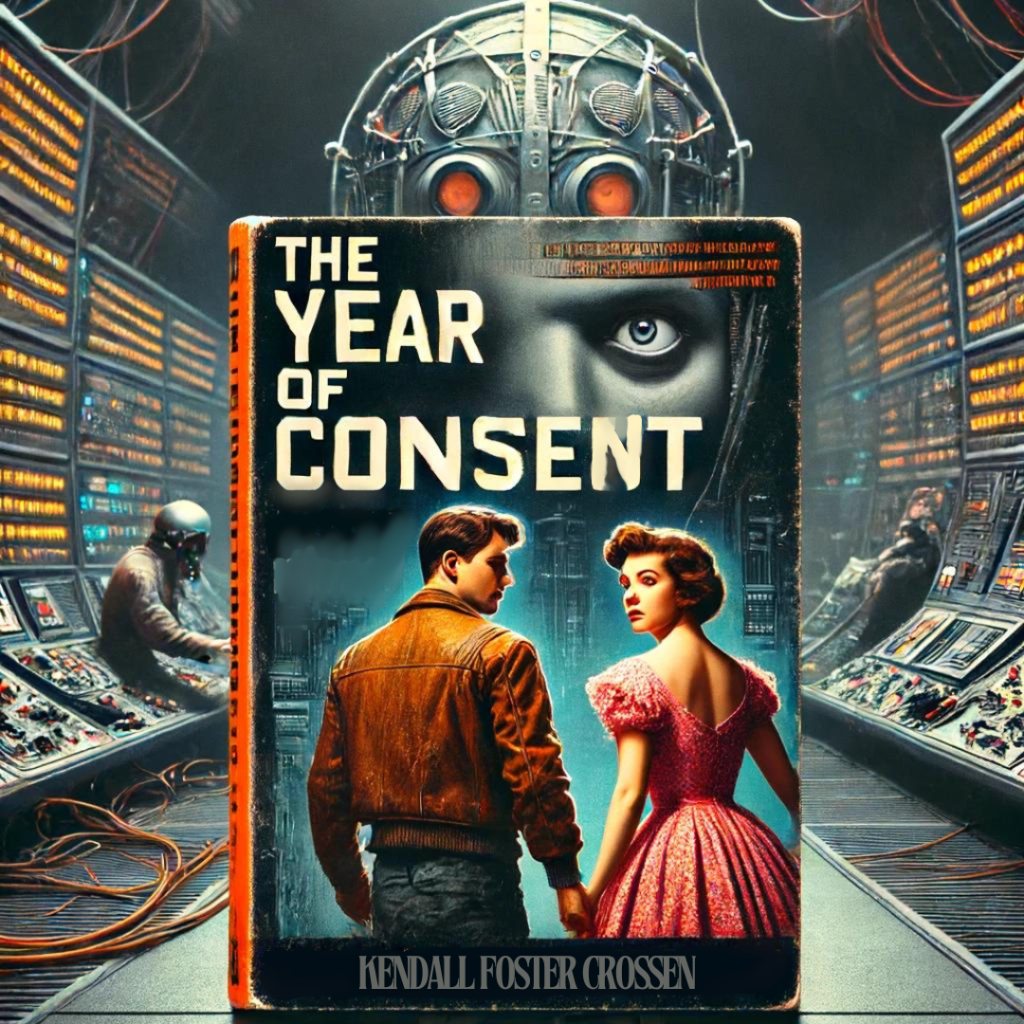In the realm of science fiction, few works delve as deeply into the themes of psychological manipulation and governmental control as Kendell Foster Crossen’s “The Year of Consent.” Published in 1954, this obscure yet profound novel presents a dystopian future where the United States is governed by a totalitarian regime that exercises absolute control over its citizens through advanced psychological tactics and pervasive surveillance. Central to this regime’s control is “The Consent,” a system designed to ensure loyalty and compliance through relentless cultural propaganda and censorship. The President of the United States is a mere spokesperson who answers to social influencers and the marketing department instead of the American people.

At the heart of “The Year of Consent” is Jim Holland, a character who transitions from a compliant citizen to a key figure in the resistance against the oppressive regime. Jim’s initial disillusionment with the government’s methods propels him into the underground resistance movement, where he engages in acts of subversion and sabotage. These actions include disseminating anti-government propaganda, hacking communication systems, and recruiting others disillusioned with the regime. Jim’s journey is marked by personal transformation, as he evolves into a leader who embodies the fight for individual freedom and autonomy against a faceless, yet ever-present “system.”
One of the novel’s most striking scenes involves Jim acting irrationally by pouring pancake syrup on his head instead of his pancakes, in the presence of Dr. Ilsa Beech, a government psychiatrist. This seemingly nonsensical act is a powerful form of rebellion against the rigid control and predictability imposed by the regime. By behaving in an unpredictable manner, Jim asserts his individuality and challenges the government’s psychological manipulation tactics. This act of non-conformity symbolizes his psychological liberation and serves as a turning point in his journey toward resistance. It also highlights the tension between Jim’s emerging individuality and the state’s efforts to suppress any form of dissent.
Dr. Ilsa Beech, initially an enforcer of the regime’s psychological control, undergoes a significant transformation as the narrative progresses. Influenced by Jim’s unique defiance and the growing resistance movement, Dr. Beech begins to question the morality and efficacy of the government’s systemic methods. Her recruitment into the resistance movement underscores the novel’s theme of awakening and the potential for change, even among those deeply entrenched in the system. This shift in allegiance highlights the broader impact of Jim’s rebellion and the possibility of dismantling the regime from within.
A crucial entity within the novel is “The Communications Department,” responsible for controlling and manipulating the flow of information to the public. This department’s primary functions include centralizing and regulating all forms of communication, creating and distributing propaganda disguised as news, entertainment and advertising, while censoring dissenting voices. The department employs sophisticated techniques to ensure that citizens receive only the approved narrative, thereby maintaining the regime’s ideological dominance. Additionally, the Communications Department engages in extensive surveillance, monitoring communications between citizens to detect and prevent subversive activities.
Does this sound familiar? It should.
The department’s role extends beyond mere censorship and propaganda; it engages in psychological manipulation to shape public opinion and ensure compliance. This includes the use of subliminal messaging, brainwashing techniques embedded in ads, and other methods designed to install and internalize the regime’s values and beliefs within the populace. The technological prowess of the Communications Department underscores the theme of how technology can be used to oppress rather than liberate, further entrenching the regime’s control over society.
Despite the novel’s relatively obscure status, “The Year of Consent” offers a compelling exploration of the dangers of unchecked storytelling power and the erosion of personal freedoms. It serves as a powerful cautionary tale about the potential for psychological manipulation and the importance of maintaining individual autonomy in the face of state control. Through Jim Holland’s journey and the depiction of the Communications Department, the novel highlights the complexities of resisting a deeply entrenched and powerful institution.
As readers reach the conclusion of “The Year of Consent,” they are left with a lingering question: Who manages our narratives today? In contemporary society, the mechanisms of control and manipulation depicted in the novel may no longer appear exaggerated, because they resonate with real-world concerns about the influence of media, technology, and government on individual thought and behavior.
The novel invites readers to reflect on the sources of their information, the forces shaping their perceptions, and the ways in which their own narratives are managed and controlled. This thought-provoking ending challenges readers to consider the balance between personal freedom and societal influence, urging them to remain vigilant in safeguarding their autonomy in an increasingly interconnected and mediated world.